Exploring Capabilities for Digital Transformation in the Business Context: Insight from a Systematic Literature Review
Abstract
1. Introduction
- What are the capabilities required for digital transformation?
- How do those capabilities facilitate digital transformation success?
2. Literature Review
3. Materials and Methods
3.1. Article Identification
3.2. Article Screening
3.3. Article Eligibility Assessment
3.4. Article Analysis
4. Results and Discussion
4.1. Digital Dynamic Capability
- Sensing capability
- Sensing capabilities refer to capacity of management to identify and interpret opportunities and threats in the external environment, including change in market demand, technological advancements, and competitive developments [32].
- Seizing capability
- Seizing capabilities are the actions taken to address the identified opportunities and threats by reconfiguring organizational resources and capabilities to address the new challenges [32]. These capabilities enable businesses to understand and recognize the modifications necessary to capture value while integrating new technologies into their business processes [16].
- Reconfiguring/transforming capability
4.2. Digital Leadership Capabilities
4.3. Employee Digital Capability
4.4. Digital Technology Capabilities
4.5. Digital Investment Capability
4.6. Discussion
5. Conclusions
5.1. Theoretical Implication
5.2. Practical Implication
5.3. Limitations and Future Research Direction
Author Contributions
Funding
Institutional Review Board Statement
Informed Consent Statement
Conflicts of Interest
Appendix A
| Reference | Document Type | Publication Title | Research Method | Business Type | Country | Capabilities for DT Mentioned in Articles |
|---|---|---|---|---|---|---|
| [1] | Journal | Benchmarking | Qualitative | Not specified | Brazil | Dynamic capabilities:
|
| [5] | Journal | Journal of Strategy and Management | Qualitative | Not specified | Not specified | Dynamic capabilities:
|
| [6] | Journal | Technological Forecasting and Social Change | Qualitative | Not specified | Not specified | Employee competency |
| [8] | Journal | Electronic Journal of Information Systems in Developing Countries | Quantitative | Banking | Indonesia | Dynamic capabilities:
|
| [10] | Journal | Long Range Planning | Qualitative | Mixed type of business | German | Dynamic capabilities: Sensing Organizing Restructuring |
| [15] | Journal | Cogent Business & Management | Mixed-method | Manufacture | Malaysia | Dynamic capabilities:
|
| [16] | Journal | Benchmarking | Literature Review | Not specified | Not specified | Digital leadership Digital dynamic capabilities:
|
| [18] | Journal | Journal of Open Innovation: Technology, Market, and Complexity | Quantitative | Banking | Indonesia | Technology capability Organizational capability Strategy capability Ecosystem capability |
| [19] | Journal | Sustainability | Quantitative | Mixed type of business | Not specified | Dynamic capabilities: Sensing Organizing Restructuring |
| [20] | Journal | European Journal of Innovation Management | Qualitative | Mixed type of business | Not specified | Dynamic capabilities:
|
| [22] | Journal | Journal of Innovation and Entrepreneurship | Quantitative | Tele-communication | Yemen | Dynamic capabilities:
|
| [23] | Journal | Advances in Intelligent Systems and Computing | Qualitative | Mixed type of business | Not specified | Leadership competencies |
| [24] | Proceeding | Proceedings of the European Conference on IS Management and Evaluation, ECIME | Literature Review | Not specified | Not specified | Agile digital culture Digital leadership skills Digital talent Transformative digital business strategy |
| [25] | Journal | Sustainability (Switzerland) | Qualitative | Manufacture | Multi country | Digital technology capability Digital operation capability Digital organization capability Digital strategy capability |
| [43] | Journal | Asian Business and Management | Qualitative | Mixed type of business | Thailand | Dynamic capabilities: Digital sensing Digital seizing Digital transforming |
| [49] | Journal (Research article) | Information Systems Journal | Qualitative | Not specified | Not specified | Management capability Infrastructure capability Networking capability Development capability |
| [58] | Journal | PLoS ONE | Literature Review | Not Specified | Not Specified | Employee digital skills Digital working skills Communication skills Adaptation skills Collaboration skills Evidence-based working skills Entrepreneurial skills |
| [26] | Journal (Research article) | Information Systems Journal | Quantitative | Not specified | Spain | Digital-first mindset Digitized practice and operation Empowered talent Data access and collaboration tools |
| [61] | Journal | Heliyon | Quantitative | Mixed type of business | Spain | IT capability |
| [48] | Journal | Management Accounting Research | Quantitative | Mixed type of business | Not specified | Tangible resources Data Technology Basic resources Intangible resources Data-driven culture Organizational learning Top management support Human skills Managerial skills Technical skills Analytical skills |
| [47] | Proceeding | Proceedings of the European Conference on Management, Leadership and Governance | Qualitative | Not specified | Not specified | Governance Resourcing Roles, responsibilities, accountabilities Skills and competence development Culture Stakeholder management Communication |
| [32] | Journal | Journal of Small Business and Entrepreneurship | Qualitative | Retail | Netherland | Dynamic managerial capability |
| [41] | Journal | Business Horizons | Qualitative | Banking | Brazil | Dynamic capabilities: Sensing capability Seizing capability Transforming capability Governance |
| [38] | Journal | Digital Business | Quantitative | Manufacture | Germany, Austria | Dynamic capabilities: Digital sensing Digital seizing Digital transforming |
| [57] | Journal | Administrative Sciences | Quantitative | Not specified | Peru | Digital competency Technical skills Strategic skills |
| [50] | Journal | Journal of Industrial Engineering and Management | Literature Review | Not specified | Not specified | Employee culture Governance Technology Organizational alignment |
| [52] | Journal | International Small Business Journal: Researching Entrepreneurship | Quantitative | Mixed type of business | Ghana | Digital capabilities Digital IT capabilities Employee digital capabilities Digital transformational leadership Digital strategy |
| [53] | Journal | Digital Business | Literature Review | Not specified | Not specified | Strategy and ecosystem capability Innovation thinking capability Digital technology capability Data capability Operations capability Organizational design capability Digital leadership |
| [42] | Proceeding | Proceedings of the Annual Hawaii International Conference on System Sciences | Literature Review | Not specified | Not specified | Dynamic capabilities: Sensing Seizing Reconfiguring Operational capabilities:
|
| [63] | Proceeding | Thirty Seventh International Conference on Information Systems | Qualitative | Mixed type of business | United states | IT capabilities IT infrastructure IT business spanning IT proactive stance |
| [54] | Journal | International Journal of Innovation and Technology Management | Quantitative | Mixed type of business | Not specified | Digital leadership IT capability |
| [51] | Journal | Journal of Business Economics and Management | Qualitative | Retail | China | Technological change capability Strategic and organizational change capability Management change capability |
| [55] | Journal | Leadership and Organization Development Journal | Qualitative | Mixed type of business | Multi country | Leadership competencies:
|
| [59] | Journal | Cogent Business & Management | Quantitative | Mixed type of business | Indonesia | Digital capability |
| [39] | Proceeding | ACIS 2020 Proceedings–31st Australasian Conference on Information Systems | Mixed method | Creative industry | Indonesia | Dynamic capabilities: Digital sensing Digital seizing Digital transforming |
| [40] | Proceeding | IEEE International Conference on Industrial Engineering and Engineering Management | Literature Review | Not specified | Not specified | Digital dynamic capabilities:
|
| [60] | Journal | Theoretical and Applied Electronic Commerce Research | Quantitative | Mixed type of business | Latvia | Digital capability |
| [33] | Journal | Journal of Cleaner Production | Qualitative | Mobility | Not specified | Dynamic capabilities:
|
| [44] | Journal | Manage Decis Econ. | Quantitative | Textile | China | Digital dynamic capabilities:
|
| [46] | Journal | Journal of Open Innovation: Technology, Market, and Complexity | Quantitative | Mixed type of business | Thailand | Knowledge-based dynamic capabilities: Absorptive capability Generation capability Storage capability Adaptation capability |
| [62] | Journal | Cogent Business and Management | Quantitative | Mixed type of business | Thailand | IT competency |
| [56] | Journal | Economic Thought and Practice | Literature review | Not specified | Not specified | Leadership competency |
References
- Froehlich, C.; Reinhardt, L.B.; Schreiber, D.; Eberle, L. Dynamic capabilities for digital transformation in an enterprise business. Benchmarking 2024. ahead of print. [Google Scholar] [CrossRef]
- Gao, S.; Hakanen, E.; Rajala, R. Digital transformation: The interplay of explorative and exploitative capability development. In Proceedings of the 53rd Hawaii International Conference on System Sciences, Maui, HI, USA, 7–10 January 2020; Volume 2020, pp. 4306–4315. [Google Scholar] [CrossRef]
- Vial, G. Understanding digital transformation: A review and a research agenda. J. Strateg. Inf. Syst. 2019, 28, 118–144. [Google Scholar] [CrossRef]
- Jing, H.; Zhang, Y.; Ma, J. Influence of digital ambidextrous capabilities on SMEs’ transformation performance: The mediating effect of business model innovation. Heliyon 2023, 9, 118–144. [Google Scholar] [CrossRef]
- Ellström, D.; Holtström, J.; Berg, E.; Josefsson, C. Dynamic capabilities for digital transformation. J. Strateg. Manag. 2022, 15, 272–286. [Google Scholar] [CrossRef]
- Blanka, C.; Krumay, B.; Rueckel, D. The interplay of digital transformation and employee competency: A design science approach. Technol. Forecast. Soc. Change 2022, 178, 121575. [Google Scholar] [CrossRef]
- Zhang, X.; Xu, Y.Y.; Ma, L. Information technology investment and digital transformation: The roles of digital transformation strategy and top management. Bus. Process. Manag. J. 2023, 29, 528–549. [Google Scholar] [CrossRef]
- Abdurrahman, A.; Gustomo, A.; Prasetio, E.A. Enhancing banking performance through dynamic digital transformation capabilities and governance, risk management, and compliance: Insights from the Indonesian context. Electron. J. Inf. Syst. Dev. Ctries. 2024, 90, e12299. [Google Scholar] [CrossRef]
- Schneider, M.H.G.; Kanbach, D.K.; Kraus, S.; Dabi, M. Transform Me If You Can: Leveraging Dynamic Capabilities to Manage Digital Transformation. IEEE Trans. Eng. Manag. 2024, 71, 9094–9108. [Google Scholar] [CrossRef]
- Warner, K.S.R.R.; Wäger, M. Building dynamic capabilities for digital transformation: An ongoing process of strategic renewal. Long Range Plann. 2019, 52, 326–349. [Google Scholar] [CrossRef]
- Forliano, C.; Bullini Orlandi, L.; Zardini, A.; Rossignoli, C. Technological orientation and organizational resilience to COVID-19: The mediating role of strategy’s digital maturity. Technol. Forecast. Soc. Change 2023, 188, 122288. [Google Scholar] [CrossRef]
- Lukito, D.; Suharnomo, S.; Perdhana, M.S. Transformation Management Capabilities for Digital Transformation Initiatives: A Construct Conceptualization in Alignment with the Dynamic Capabilities Framework. J. Organ. Manag. Stud. 2022, 2022, 845443. [Google Scholar] [CrossRef]
- Xu, Z.; Hou, J. CEO overseas experience, dynamic capabilities and corporate digital transformation: An imprinting theory perspective. Humanit. Soc. Sci. Commun. 2024, 11, 743. [Google Scholar] [CrossRef]
- Wu, W.; Song, J.; Lu, L.; Guo, H. Is managerial ability a catalyst for driving digital transformation in enterprises? An empirical analysis from internal and external pressure perspectives. PLoS ONE 2024, 19, e0293454. [Google Scholar] [CrossRef]
- Ahmed, S.; Aziz, N.A.; Haque, R.; Bin, A.R.; Senathirajah, S.; Qazi, S.Z. Digital transformation in Malaysian manufacturing: A study of change sensing and seizing capabilities. Cogent Bus. Manag. 2024, 11, 2392046. [Google Scholar] [CrossRef]
- Albannai, N.A.; Raziq, M.M.; Malik, M.; Scott-Kennel, J.; Igoe, J. Unraveling the role of digital leadership in developing digital dynamic capabilities for the digital transformation of firms. Benchmarking 2024. ahead of print. [Google Scholar] [CrossRef]
- Busulwa, R.; Pickering, M.; Mao, I. Digital transformation and hospitality management competencies: Toward an integrative framework. Int. J. Hosp. Manag. 2022, 102, 103132. [Google Scholar] [CrossRef]
- Abdurrahman, A.; Gustomo, A.; Prasetio, E.A.; Agus, E. Impact of dynamic capabilities on digital transformation and innovation to improve banking performance: A TOE framework study. J. Open Innov. Technol. Mark. Complex. 2024, 10, 100215. [Google Scholar] [CrossRef]
- Yu, J.; Wang, J.; Moon, T. Influence of Digital Transformation Capability on Operational Performance. Sustainability 2022, 14, 7909. [Google Scholar] [CrossRef]
- Kowalski, M.; Bernardes, R.C.; Gomes, L.; Borini, F.M. Microfoundations of dynamic capabilities for digital transformation. Eur. J. Innov. Manag. 2024. ahead of print. [Google Scholar] [CrossRef]
- Wu, M.; Kozanoglu, D.C.; Min, C.; Zhang, Y. Unraveling the capabilities that enable digital transformation: A data-driven methodology and the case of artificial intelligence. Adv. Eng. Inform. 2021, 50, 101368. [Google Scholar] [CrossRef]
- Al-Moaid, N.A.A.; Almarhdi, S.G. Developing dynamic capabilities for successful digital transformation projects: The mediating role of change management. J. Innov. Entrep. 2024, 13, 85. [Google Scholar] [CrossRef]
- Imran, F.; Shahzad, K.; Butt, A.; Kantola, J. Leadership Competencies for Digital Transformation: Evidence from Multiple Cases. Adv. Intell. Syst. Comput. 2020, 1209, 81–87. [Google Scholar] [CrossRef]
- Carcary, M.; Doherty, E.; Conway, G. A dynamic capability approach to Digital transformation: A focus on key foundational themes. In Proceedings of the 10th European Conference on Information Systems Management: ECISM 2016, Évora, Portugal, 8–9 September 2016; pp. 20–28. [Google Scholar]
- Ren, X.; Jing, H.; Zhang, Y. Construction of Digital Transformation Capability of Manufacturing Enterprises: Qualitative Meta-Analysis Based on Current Research. Sustainability 2023, 15, 14168. [Google Scholar] [CrossRef]
- Braojos, J.; Weritz, P.; Matute, J. Empowering organisational commitment through digital transformation capabilities: The role of digital leadership and a continuous learning environment. Inf. Syst. J. 2024, 34, 1466–1492. [Google Scholar] [CrossRef]
- del Socorro Encinas-Grijalva, M.; Olivieri-Sangiacomo, F.A.; Galván-Vela, E.; Ravina-Ripoll, R. Business readiness for dual transformation: An analysis of business capabilities for digital and sustainable transformation. Discov. Sustain. 2024, 5, 164. [Google Scholar] [CrossRef]
- Zia, N.U.; Shamim, S.; Zeng, J.; Awan, U.; Chromjakova, F.; Akhtar, P.; Orel, M. Avoiding crisis-driven business failure through digital dynamic capabilities. B2B distribution firms during the COVID-19 and beyond. Ind. Mark. Manag. 2023, 113, 14–29. [Google Scholar] [CrossRef]
- Nguyen, T.H.; Le, X.C. An Extended Technology-Organization-Environment (TOE) Framework for Online Retailing Utilization in Digital Transformation: Empirical Evidence from Vietnam. J. Open Innov. Technol. Mark. Complex. 2022, 8, 200. [Google Scholar] [CrossRef]
- Hussein, H.; Albadry, O.M.; Mathew, V.; Al-Romeedy, B.S.; Alsetoohy, O.; Abou Kamar, M.; Khairy, H.A. Digital Leadership and Sustainable Competitive Advantage: Leveraging Green Absorptive Capability and Eco-Innovation in Tourism and Hospitality Businesses. Sustainability 2024, 16, 5371. [Google Scholar] [CrossRef]
- Teece, D.J. Business models and dynamic capabilities. Long Range Plann. 2018, 51, 40–49. [Google Scholar] [CrossRef]
- Dasí, À.; Kok, G.J.M. Without friction, no shine: How dynamic managerial capabilities combine for family firms’ digital transformation. J. Small Bus. Entrep. 2023, 37, 145–171. [Google Scholar] [CrossRef]
- Saeedikiya, M.; Salunke, S.; Kowalkiewicz, M. Toward a dynamic capability perspective of digital transformation in SMEs: A study of the mobility sector. J. Clean. Prod. 2024, 439, 140718. [Google Scholar] [CrossRef]
- Fitzgerald, M.; Kruschwitz, N.; Bonnet, D.; Welch, M. Embracing Digital Technology. A New Strategic Imperative|Capgemini Consulting Worldwide. MIT Sloan Manag. Rev. 2014, 55, 1–13. [Google Scholar]
- Kane, G. The Technology Fallacy: People Are the Real Key to Digital Transformation. Res. Technol. Manag. 2019, 62, 44–49. [Google Scholar] [CrossRef]
- Moher, D.; Liberati, A.; Tetzlaff, J.; Altman, D.G.; Group, P. Preferred reporting items for systematic reviews and meta-analyses: The PRISMA statement. BMJ 2009, 2535, b2535. [Google Scholar] [CrossRef] [PubMed]
- Samsuden, N.S.; Kohar, U.H.A.; Khatib, S.F.A.; Abbas, A.F. Digital Capabilities and Business Performance: A Systematic Literature Review. Sustainability 2024, 16, 11108. [Google Scholar] [CrossRef]
- Dobrovnik, M.; Herold, D.M.; Kummer, S. Exploring supply chain managers’ complex perceptions of dynamic capabilities for digital transformation. Digit. Bus. 2025, 5, 100098. [Google Scholar] [CrossRef]
- Priambada, S.; Korthaus, A.; Bennett, R.M.; Scifleet, P. Exploring Dynamic Capabilities, Digital Business Transformation and Indonesia’s Creative Industry Sector. In Proceedings of the ACIS 2020 Proceedings—31st Australasian Conference on Information Systems, Wellington, New Zealand, 1–4 December 2020. [Google Scholar]
- Rizana, A.F.; Wiratmadja, I.I.; Akbar, M. Exploring the Role of Digital Transformation for Agile and Resilience Business: A Conceptual Model Based on Dynamic Capabilities View. In Proceedings of the 2024 IEEE International Conference on Industrial Engineering and Engineering Management (IEEM), Bangkok, Thailand, 15–18 December 2024; pp. 868–872. [Google Scholar] [CrossRef]
- de Paula Pereira, G.; de Medeiros, J.F.; Kolling, C.; Ribeiro, J.L.D.; Morea, D.; Iazzolino, G. Using dynamic capabilities to cope with digital transformation and boost innovation in traditional banks. Bus. Horiz. 2024, 67, 317–330. [Google Scholar] [CrossRef]
- Koppe, T.; Leisching, L.; Rasspe, S. Management of Digital Transformation: A Literature Review of Dynamic and Operational Capabilities. In Proceedings of the 56th Hawaii International Conference on System Sciences, Maui, HI, USA, 3–6 January 2023; pp. 4204–4213. [Google Scholar]
- Borsano, P.; Marozzo, V.; Bonaglia, M.; Di Minin, A.; Crupi, A. Digital transformation and digital dynamic capabilities improvement in low-medium technology sector: Evidence from Thai family firms. Asian Bus. Manag. 2024, 23, 683–712. [Google Scholar] [CrossRef]
- Shen, L.; Zhang, X. Digital technology adoption, digital dynamic capability, and digital transformation performance of textile industry: Moderating role of digital innovation orientation. Manag. Decis Econ. 2022, 43, 2038–2054. [Google Scholar] [CrossRef]
- Ghosh, S.; Hughes, M.; Hodgkinson, I.; Hughes, P. Digital transformation of industrial businesses: A dynamic capability approach. Technovation 2022, 113, 102414. [Google Scholar] [CrossRef]
- Songkajorn, Y.; Aujirapongpan, S.; Jiraphanumes, K.; Pattanasing, K. Organizational Strategic Intuition for High Performance: The Role of Knowledge-Based Dynamic Capabilities and Digital Transformation. J. Open Innov. Technol. Mark. Complex. 2022, 8, 117. [Google Scholar] [CrossRef]
- Carcary, M.; Doherty, E. Digital Transformation: A Foundational Capability Building Block Perspective on Maturing the IT Capability. In Proceedings of the ECMLG 2022 18th European Conference on Management, Leadership and Governance, Lisbon, Portugal, 10–11 November 2022; pp. 80–88. [Google Scholar] [CrossRef]
- Boerner, X.; Wiener, M.; Guenther, T.W. Controllership effectiveness and digitalization: Shedding light on the importance of business analytics capabilities and the business partner role. Manag. Account. Res. 2024, 66, 100904. [Google Scholar] [CrossRef]
- Baiyere, A.; Salmela, H.; Nieminen, H.; Kankainen, T. Assessing digital capabilities for digital transformation—The MIND framework. Inf. Syst. J. 2024, 35, 6–38. [Google Scholar] [CrossRef]
- González-Varona, J.M.; Acebes, F.; Poza, D.; López-Paredes, A. Fostering Digital Growth in SMEs: Organizational Competence for Digital Transformation. IFIP Adv. Inf. Commun. Technol. 2020, 598, 237–248. [Google Scholar] [CrossRef]
- Pan, J.; Lin, J.; Wang, S. a Delphi-Based Index System for Digital Transformation Capability of Retailers. J. Bus. Econ. Manag. 2022, 23, 1106–1132. [Google Scholar] [CrossRef]
- Gyamerah, S.; Afshari, L.; Asante, D. Digital transformation in the SME context: The nexus between leadership, digital capabilities and digital strategy. Int. Small Bus. J. Res. Entrep. 2025, 43, 303–328. [Google Scholar] [CrossRef]
- Konopik, J.; Jahn, C.; Schuster, T.; Hoßbach, N.; Pflaum, A. Mastering the digital transformation through organizational capabilities: A conceptual framework. Digit. Bus. 2022, 2, 100019. [Google Scholar] [CrossRef]
- Ongena, G.; Morsch, P.; Ravesteijn, P. Digital Leadership Competency to Enhance Digital Transformation. Int. J. Innov. Technol. Manag. 2024, 21, 2450042. [Google Scholar] [CrossRef]
- Philip, J.; Gilli, K.; Knappstein, M. Identifying key leadership competencies for digital transformation: Evidence from a cross-sectoral Delphi study of global managers. Leadersh. Organ. Dev. J. 2023, 44, 392–406. [Google Scholar] [CrossRef]
- Živković, S. Inspiring Digital Transformation: An Integrative Leadership Competency Framework. Econ. Thought Pract. 2022, 31, 237–254. [Google Scholar] [CrossRef]
- Espina-Romero, L.; Chafloque-Céspedes, R.; Izaguirre Olmedo, J.; Albarran Taype, R.; Ochoa-Díaz, A. Driving Digital Transformation in Lima’s SMEs: Unveiling the Role of Digital Competencies and Organizational Culture in Business Success. Adm. Sci. 2025, 15, 19. [Google Scholar] [CrossRef]
- Bouwmans, M.; Lub, X.; Orlowski, M.; Nguyen, T.V. Developing the digital transformation skills framework: A systematic literature review approach. PLoS ONE 2024, 19, e0304127. [Google Scholar] [CrossRef]
- Prakasa, Y.; Jumani, Z.A. Linking digital capability to small business performance: The mediating role of digital business transformation. Cogent Bus. Manag. 2024, 11, 2342486. [Google Scholar] [CrossRef]
- Rupeika-apoga, R.; Petrovska, K.; Bule, L. The Effect of Digital Orientation and Digital Capability on Digital Transformation of SMEs during the COVID-19 Pandemic. Theor. Appl. Electron. Commer. Res. 2022, 17, 669–685. [Google Scholar] [CrossRef]
- Barba-Sánchez, V.; Meseguer-Martínez, A.; Gouveia-Rodrigues, R.; Raposo, M.L. Effects of digital transformation on firm performance: The role of IT capabilities and digital orientation. Heliyon 2024, 10, e27725. [Google Scholar] [CrossRef] [PubMed]
- Ueasangkomsate, P. Empowering Thai SMEs through IT competency, digitalization and digital transformation for new product development. Cogent Bus. Manag. 2025, 12, 2458758. [Google Scholar] [CrossRef]
- Nwankpa, J.K.; Roumani, Y. IT Capability and Digital Transformation: A Firm Performance Perspective IT Capability and Digital Transformation: A Firm Performance Perspective. In Proceedings of the Thirty Seventh International Conference on Information Systems, Dublin, Ireland, 11–14 December 2016. [Google Scholar]
- Teece, D.J. Explicating Dynamic Capabilities: The Nature and Microfoundations of (Sustainable) Enterprise Performance. Strateg. Manag. J. 2007, 1350, 1319–1350. [Google Scholar] [CrossRef]
- AlNuaimi, B.K.; Kumar Singh, S.; Ren, S.; Budhwar, P.; Vorobyev, D. Mastering digital transformation: The nexus between leadership, agility, and digital strategy. J. Bus. Res. 2022, 145, 636–648. [Google Scholar] [CrossRef]
- Teece, D.; Peteraf, M.; Leih, S. Dynamic capabilities and organizational agility: Risk, uncertainty, and strategy in the innovation economy. Calif. Manage. Rev. 2016, 58, 13–35. [Google Scholar] [CrossRef]
- Gouveia, S.; De Iglesia, D.H.; Abrantes, J.L.; Rivero, A.J.L. Transforming Strategy and Value Creation Through Digitalization? Adm. Sci. 2024, 14, 307. [Google Scholar] [CrossRef]
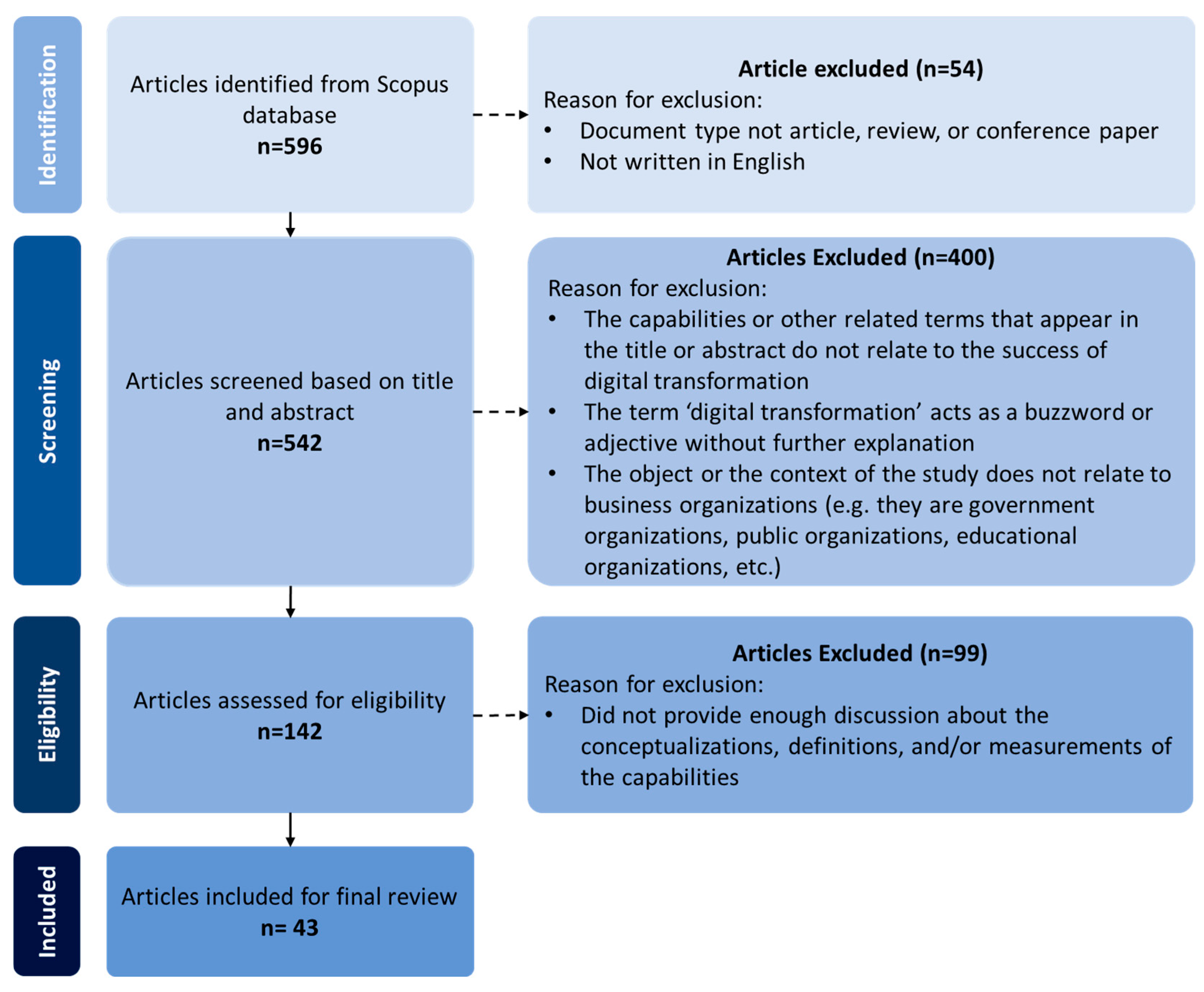
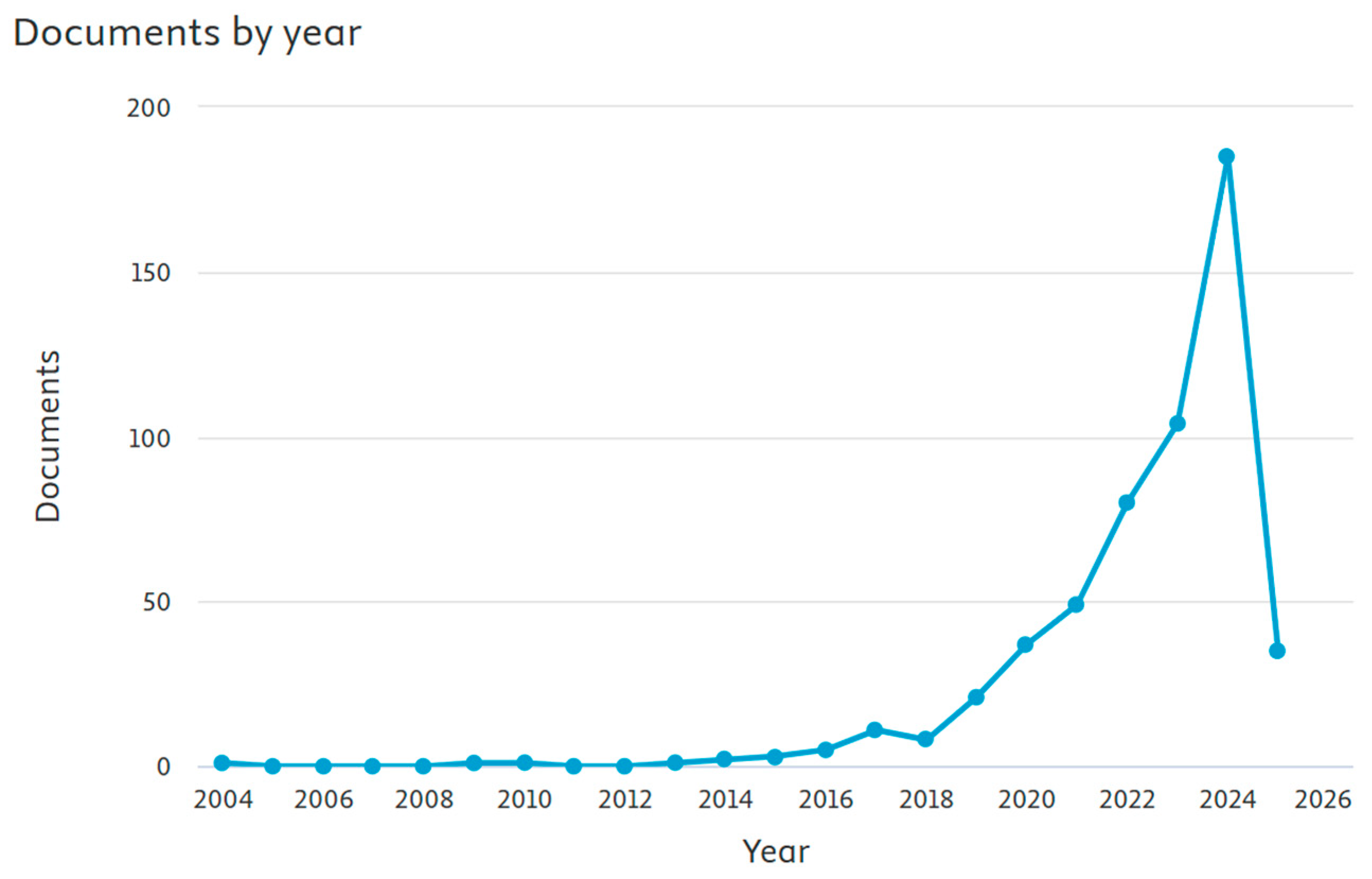
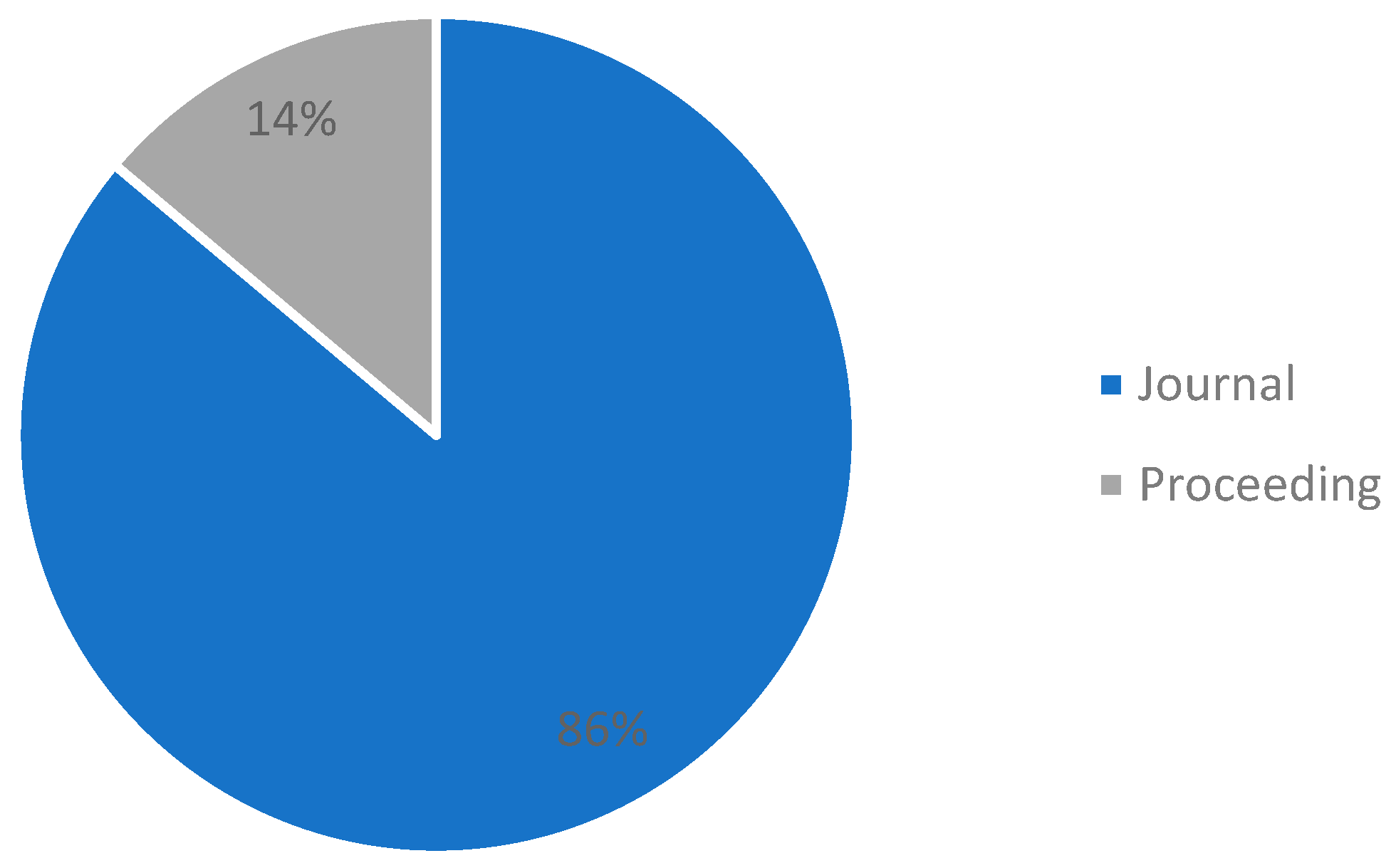


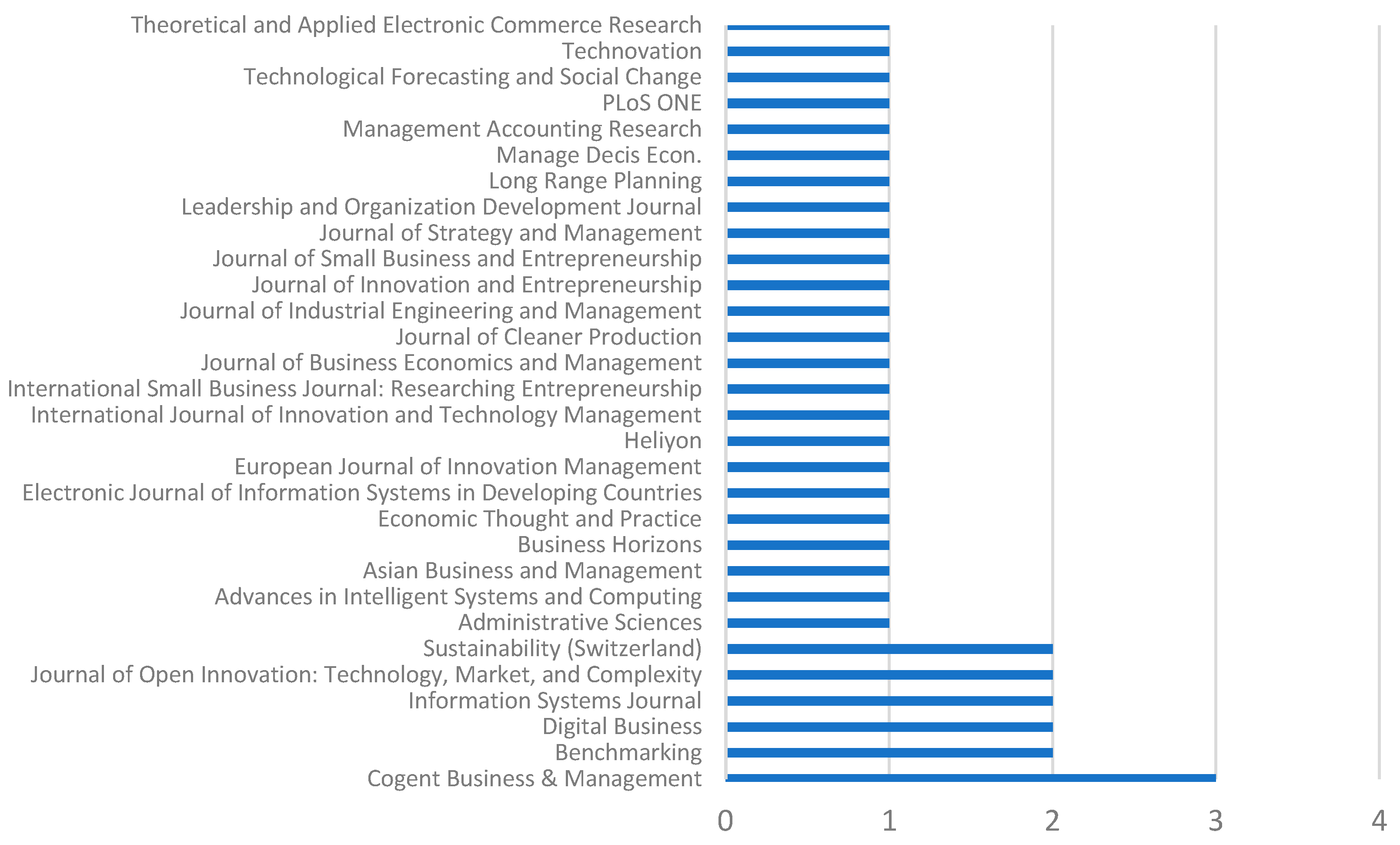

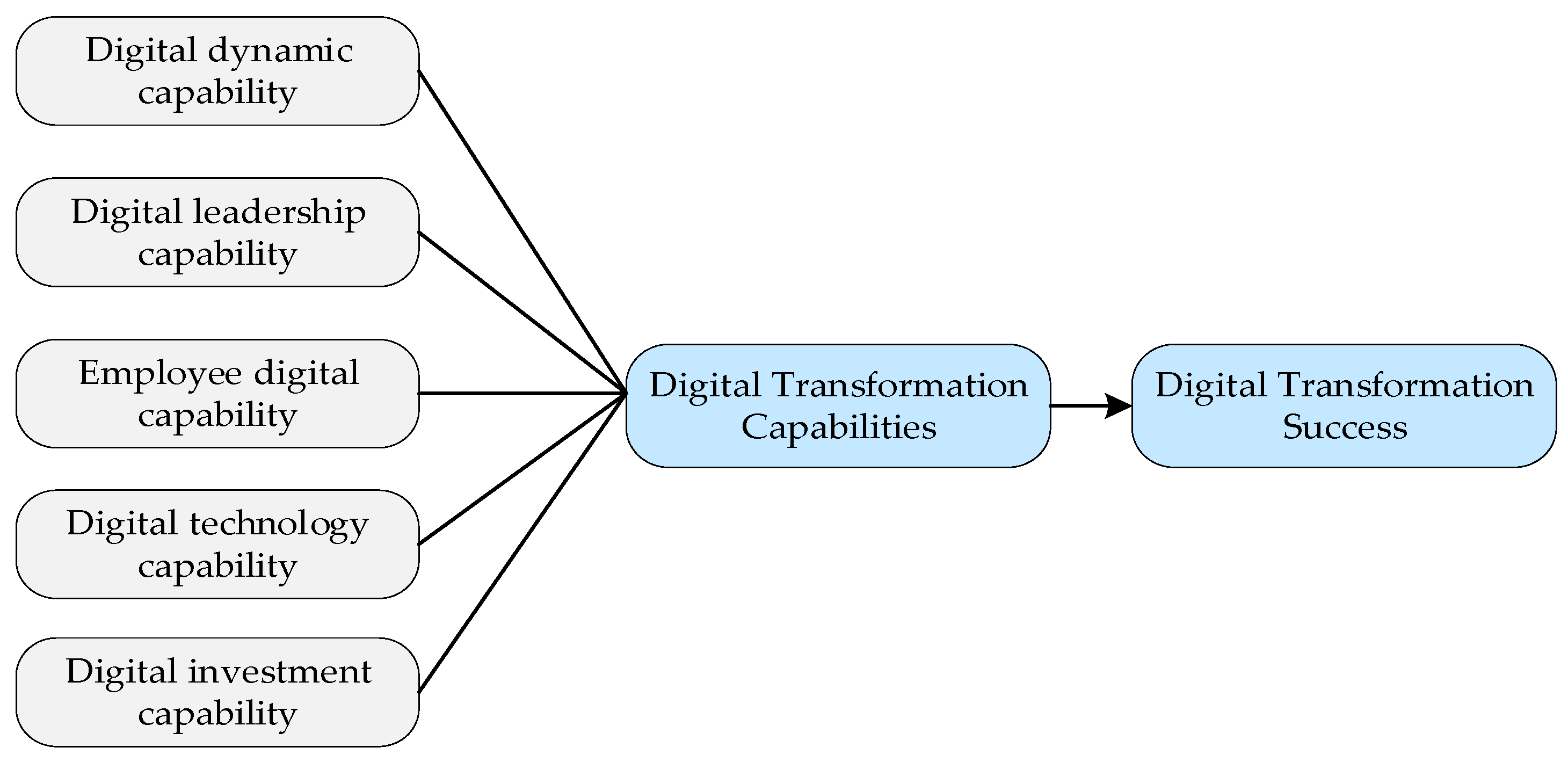
| Cluster | Theme | Keywords | Description |
|---|---|---|---|
| 1 | Leadership capability and organizational culture as enabler of digital transformation | Digital transformation, digitalization, digital leadership, leadership, leadership competencies, and organizational culture | Focus on the human aspect in digital transformation initiatives where leadership capability and organizational culture facilitate the success of digital transformation |
| 2 | Digital and IT capabilities as drivers of innovation and firm performance | Digital capability, digital orientation, firm performance, innovation, IT capability | Focus on the development of technical capabilities (digital capabilities, IT capabilities, digital orientation) and how these capabilities contribute to organizational innovation and improved firm performance |
| 3 | Dynamic capabilities to navigate digital transformation | Dynamic capability, digital transformation capability, and sensing | Focus on the importance of dynamic capability as key enabler for organizations to adapt and evolve in response to digital disruption |
| Capabilities Mentioned in Studies | References | Synthesize Capability |
|---|---|---|
| Dynamic capabilities | [1,5,8,10,15,19,20,22,33,38,39,40,41,42,43] | Digital dynamic capability |
| Digital dynamic capability | [16,40,44,45] | |
| Knowledge-based dynamic capabilities | [46] | |
| Dynamic managerial capability | [32] | |
| Management capability | [47,48,49] | Digital leadership capability |
| Stakeholder management | [47] | |
| Governance | [47,50] | |
| Organizational capability | [18,25,26] | |
| Communication | [47] | |
| Change management | [22,51] | |
| Digital leadership | [16,24,52,53,54] | |
| Leadership competencies | [23,55,56] | |
| Digital strategy | [24,25,51,52] | |
| Strategy capability | [18,53,57] | |
| Organizational alignment | [50] | |
| Digital mindset | [26] | |
| Digital culture | [24,51] | |
| Organization culture | [47,50] | |
| Data-driven culture | [48] | |
| Employee competency | [6] | Employee digital capability |
| Digital talent | [24,26,51,58] | |
| Employee capability | [48,50,52] | |
| Employee technical skill | [48] | |
| Employee analytical skill | [48] | |
| Digital capability | [42,52,53,57,59,60] | Digital technology and operation capability |
| IT Capability | [42,52,54,61,62,63] | |
| Technology capability | [18,25,48,50,51] | |
| Digital operation and practice | [25,26,42,51,53] | |
| Data availability | [26,48,53] | Digital investment capability |
| Infrastructure capability | [49] | |
| Basic resource availability | [48] | |
| Resourcing capability | [47] |
| Attribute | References |
|---|---|
| Constantly monitoring changes in digital technology trends | [5] |
| Identifying new opportunities related to the strategic use of digital technologies | [5] |
| Determining the need for a digital transformation strategy | [5] |
| Formulating digital transformation strategies | [5] |
| Allocating resources for digital transformation | [22] |
| Combining internal and external resources for digital transformation | [22] |
| Prioritizing digital transformation investments based on the expected impact on business performance | [22] |
| Improving digital maturity | [15,22] |
| Hiring the right digital talent for digital transformation | [15,22] |
| Adjusting organizational structures to adapt to digital transformation | [15,22] |
| Attribute | References |
|---|---|
| Articulates a clear vision and develops strategies to harness digital technologies for competitive advantage | [24,52] |
| Translates organizational goals to strategic digital activities | [49] |
| Ensures digital initiatives align with business objectives | [49] |
| Motivates employees to embrace digital transformation by conducting training workshops | [22,52] |
| Encourages all members to achieve digital transformation goals for the organization. | [52] |
| Fosters digital culture | [16,49] |
| Ensures that the company has a change management plan before implementing it | [22] |
| Effectively communicates the purpose and benefits of digital transformation initiatives | [15,22] |
| Proposes a structured process for managing changes associated with digital transformation | [15,22] |
| Knows how to address and overcome resistance to digital changes | [15] |
| Forms a change management team | [22] |
| Attribute | References |
|---|---|
| In general, the employees possess necessary skills to adopt new digital technologies | [15,22,26,52] |
| Digital skills are widely distributed across the organization | [26] |
| The business has employees with data analytic skills | [48,58,60] |
| The business has employees with data management skills | [58,60] |
| The business has employees able to solve basic digital problems | [58] |
| The business has employees with programming skills | [58] |
| The business has employees able to create digital content | [58] |
| The employees are familiar with a variety of hardware | [58] |
| The employees able to utilize relevant software in performing tasks | [58,60] |
| Attribute | References |
|---|---|
| The business has an information technology department | [62] |
| The business’s operational processes are mostly automated and digitized | [22,26] |
| The business stores all data in digital form | [26,62] |
| The business uses various software and digital applications to support business activities (e.g., mobile applications, social media tools and data, big data and advanced analytics, artificial intelligence, machine learning, and Internet of Things) | [26,59] |
| The business facilitates access to a variety of digital devices to support business activities | [59,62] |
| The business provides access to a variety of IT or digital devices | [52] |
| The business utilizes data management services and architectures (e.g., databases, data warehousing, data availability, storage, accessibility, sharing, etc.) | [63] |
| Decision making in the business’s operations is supported by data analysis | [62] |
| The business uses digital technology to support standardized operational processes | [62] |
| Attribute | References |
|---|---|
| The business invests in technology to collect, store, process, and share a large volume of data | [48] |
| The business allocates a budget for digital transformation initiatives | [15,48] |
| The business continuously invests in upgrading technological infrastructure | [15] |
| The business’s current technological resources are sufficient to meet current digital trends | [15] |
| The business recruits digital talent when needed | [47] |
| The business has enough team members to support digital initiatives | [15,48] |
| The business invests in training programs to enhance employees’ digital competencies | [15,47] |
| Capability | Role in Digital Transformation |
|---|---|
| Digital dynamic capability | |
| Digital leadership capability | |
| Employee digital capability | |
| Digital technology and operation capability |
|
| Digital investment capability |
|
Disclaimer/Publisher’s Note: The statements, opinions and data contained in all publications are solely those of the individual author(s) and contributor(s) and not of MDPI and/or the editor(s). MDPI and/or the editor(s) disclaim responsibility for any injury to people or property resulting from any ideas, methods, instructions or products referred to in the content. |
© 2025 by the authors. Licensee MDPI, Basel, Switzerland. This article is an open access article distributed under the terms and conditions of the Creative Commons Attribution (CC BY) license (https://creativecommons.org/licenses/by/4.0/).
Share and Cite
Rizana, A.F.; Wiratmadja, I.I.; Akbar, M. Exploring Capabilities for Digital Transformation in the Business Context: Insight from a Systematic Literature Review. Sustainability 2025, 17, 4222. https://doi.org/10.3390/su17094222
Rizana AF, Wiratmadja II, Akbar M. Exploring Capabilities for Digital Transformation in the Business Context: Insight from a Systematic Literature Review. Sustainability. 2025; 17(9):4222. https://doi.org/10.3390/su17094222
Chicago/Turabian StyleRizana, Afrin Fauzya, Iwan Inrawan Wiratmadja, and Muhammad Akbar. 2025. "Exploring Capabilities for Digital Transformation in the Business Context: Insight from a Systematic Literature Review" Sustainability 17, no. 9: 4222. https://doi.org/10.3390/su17094222
APA StyleRizana, A. F., Wiratmadja, I. I., & Akbar, M. (2025). Exploring Capabilities for Digital Transformation in the Business Context: Insight from a Systematic Literature Review. Sustainability, 17(9), 4222. https://doi.org/10.3390/su17094222








